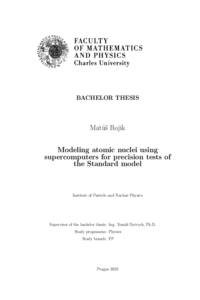Modeling atomic nuclei using supercomputers for precision tests of the Standard model
Modelování atomových jader na superpočítačích pro přesné testy Standardního modelu
bakalářská práce (OBHÁJENO)

Zobrazit/
Trvalý odkaz
http://hdl.handle.net/20.500.11956/184054Identifikátory
SIS: 229219
Kolekce
- Kvalifikační práce [11978]
Autor
Vedoucí práce
Oponent práce
Knapp, František
Fakulta / součást
Matematicko-fyzikální fakulta
Obor
Fyzika
Katedra / ústav / klinika
Ústav částicové a jaderné fyziky
Datum obhajoby
5. 9. 2023
Nakladatel
Univerzita Karlova, Matematicko-fyzikální fakultaJazyk
Angličtina
Známka
Výborně
Klíčová slova (česky)
standardní model|beta rozpady|jaderná struktura|ab initio metodyKlíčová slova (anglicky)
standard model|beta decay|nuclear stucture|ab initio methodsJedným z najdôležitejších problémov modernej teoretickej jadrovej fyziky je schop- nosť presne predpovedať štruktúru atómových jadier. Na získanie výsledkov, ktoré súh- lasia s experimentálnymi údajmi, je protebné vyriešiť mnoho častičový jadrový problém s dostatočne vysokou presnosťou. Ab initio metódy sa pokúšajú vyriešiť tento problém tak, že riešia vzniklú Schrödingerovu rovnicu pre všetky nukleóny a s realistickými in- terakciami. Kvôli vysokým výpočetným nárokom ich bolo donedávna možné aplikovať len na ľahké jadrá. V tejto práci stručne prezentujeme teóriu za tzv. symmetry-adapted no-core shell modelom, ktorý umožňuje na základe vnútornej symetrií jadier zmenšiť modelový priestor, čím sa dosiahne zníženie dimenzie matice Hamiltoniánu, pričom os- tane zachovaná konvergencia vypočítaných maticových elementov. Pomocou štúdia beta rozpadov rôznych jadier skúmame schopnosti tohto modelu predpokladať výsledky, ktoré súhlasia s experimentom a diskutujeme možné použitia tohto modelu pre skúmanie fyziky za hranicami štandardného modelu. 1
One of the most important problems of modern theoretical nuclear physics is to accu- rately determine the structure of atomic nuclei. To obtain results that are in agreement with experimental data, one needs to solve the nuclear many-body problem with high enough precision. Ab initio methods address this problem by trying to solve the emergent Schrödinger equation for all nucleons with a realistic interaction. Until recently, they were applicable only to light nuclei because of the high computational demands. In this work, we briefly present the theory behind the symmetry-adapted no-core shell model, which allows for truncation of the model space based on innate symmetry of nuclei that leads to reduction of the Hamiltonian matrix dimensions, while the convergence of the full space is conserved. We explore its predictive power by studying beta decays of various nuclei and discuss possible applications of the symmetry-adapted no-core shell model for the study of physics beyond the Standard Model. 1
